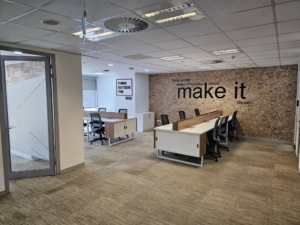Title: The Future of Office Space: Redefining the Workplace in a Post-Pandemic World

Introduction:
The concept of office space has undergone a profound transformation in recent years. What was once a straightforward matter of square footage and desk arrangements has become a complex equation involving flexibility, technology, and employee well-being. As a leader in the real estate industry, it’s crucial to explore these changes and what they mean for businesses, employees, and the future of work.
The Shift to Hybrid Work Models:
The COVID-19 pandemic accelerated the adoption of remote work, leading many companies to rethink their office space needs. The rise of hybrid work models, where employees split their time between home and the office, has challenged the traditional workplace concept. This shift requires adaptable office spaces, allowing for a blend of in-person collaboration and remote work capabilities.
Flexibility as a Key Factor:
In today’s dynamic business environment, flexibility is not just a buzzword—it’s a necessity. Modern office spaces must cater to the changing needs of businesses, offering the ability to scale up or down as required. This has led to the growing popularity of flexible workspaces and co-working environments, which provide businesses with the agility to adapt to market changes without the burden of long-term leases.
Technology-Driven Workspaces:
The integration of technology into office spaces has become a critical factor in enhancing productivity and employee satisfaction. From high-speed internet and video conferencing facilities to smart office solutions that monitor and optimize the use of space, technology is at the heart of the modern workplace. As businesses continue to adopt new tools and platforms, the demand for tech-enabled office spaces will only increase.
Employee Well-Being and Office Design:
The focus on employee well-being has never been more important. Companies are recognizing that the design of their office space can have a significant impact on employee health, morale, and productivity. Features such as natural lighting, ergonomic furniture, green spaces, and wellness amenities are becoming standard in modern office design. Creating a workspace that promotes well-being is not just about aesthetics; it’s about fostering a positive work culture and improving overall business performance.
Sustainability and Eco-Friendly Workspaces:
Sustainability is no longer an option but a priority for many businesses. Eco-friendly office spaces, designed with energy efficiency and environmental impact in mind, are in high demand. This includes everything from sustainable building materials and energy-efficient systems to waste reduction programs and green certifications. As companies strive to meet their sustainability goals, the demand for green office spaces will continue to rise.
The Role of Location in the New Era:
Location remains a critical factor in office space decisions, but the criteria have evolved. Proximity to talent pools, access to transportation, and the surrounding amenities are all essential considerations. In addition, with more employees working remotely, the emphasis on central business districts may diminish, giving rise to decentralized office hubs closer to where employees live.

